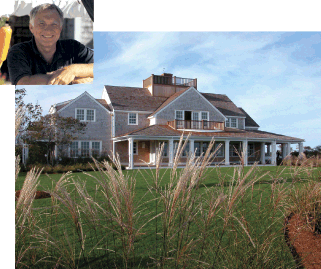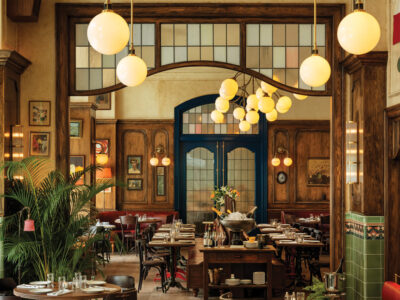
Class of ’68 | Not long after Lyman Perry GAr’68 began practicing architecture in 1973, a Philadelphia attorney approached him at a cocktail party with a commission for a small vacation house. Perry, then a lecturer at Penn, had only handled some modest renovation jobs, but the challenge intrigued him and he accepted it.
It was, as they say, a good career move: The finished product won Architectural Record magazine’s House of the Year award.
“It was constructed to be evocative of a barn sitting on a hill,” recalls Perry, “and it felt at home with the rest of the structures on the site. It’s important to me to understand the vernacular of wherever you’re working, and to have it feel as if it belongs, that it’s not alien to its context; I’m not just doing cubes in the landscape. I designed big barn doors that slid across to close off porches and entries when you weren’t there, which was evocative of a farmhouse, but it was still modern enough to get the attention of Architectural Record. So I sort of hit a home run on the first house.”
Other successful projects followed for Lyman S. A. Perry Architects, including a school and a much-photographed cottage for himself on Nantucket, Perry’s second home. (To see that and other projects, visit his website: www.lparchitects.com.) He is now arguably the most influential architect on the island, having designed the Nantucket Golf Club and recently accepted a commission to design the new Nantucket Yacht Club. His work has received numerous awards; appeared in magazines, books, and television programs; and found a place in America’s Elite 1000. His primarily residential projects, characterized by their clean lines, simple massing, and innovative references to local vernacular styles, have become internationally known, and his clients range from academics to heads of Fortune 500 corporations.
Not bad for a guy who was turned down when he first applied to Penn’s architecture program.
Perry didn’t grow up with a burning desire to become an architect. The son of a Naval officer, he entered the United States Naval Academy, where he became an avid rower and a member of the Academy’s 1960 Olympic crew team. Although he still rows competitively—on the day of our interview he had risen at 4 a.m. for a brisk workout on the Schuylkill River —and still sails (he raced his yacht, True Blue, in the Annapolis to Newport race in 2001), he decided that a career in the Navy was not for him.
Instead, his strong command of engineering and mathematics, coupled with a lifelong love of drawing, inspired him to apply to architecture school—and, in the mid-1960s, he felt there was no better place to study architecture than Penn.
“Robert Venturi [Hon’80] was there, and Lou Kahn [Ar’24 Hon’71],” Perry remembers. “It was a really seminal place for architectural thought—it’s hard to even describe to somebody—and I got there just as it was beginning to boil.”
Perry had one problem: he had no portfolio or architectural background. Predictably, his initial application was rejected, but disappointment was quickly replaced by determination. “I’d drawn—I’d sketched, even at the Naval Academy. So I took some drawing courses, and I took history of art, and I took some of the qualifying courses, and I got my foot in the door.”
Among Perry’s introductory courses was a now-legendary design studio taught by architecture professor Stanislawa Nowicki. “It was a wonderful experience,” Perry remembers. “I had been in command of a submarine for a brief period, and all of a sudden I was cutting out pieces of paper and finger painting and getting in touch with my intuitive self. I just blossomed there.”
Eventually, the late G. Holmes Perkins Hon’72, then dean of the school, consented to admit Perry on the condition that he undergo a review after one year. After the trial period had elapsed, Perry was shocked to discover that he had earned the Warren Powers Laird Medal, presented to the top architecture graduate student. His successes continued, and upon completing the program in 1968, Perry took the Brooke Gold Medal for Design.
After graduating, Perry worked for several top Philadelphia architecture firms. Then he received a call from Perkins—inviting him to join the faculty of the very school that had rejected him only a few years earlier.
“All of this was a complete shock,” he says. “I felt totally inadequate. I hadn’t had the history; I didn’t have any of the humanities.”
What Perry did have was a genuine urge to help his students find their creative voices; he traces his development into a mature architect to this period in his life.
“I basically run my practice now by a lot of the precepts I developed then,” he says. “Teaching forced me to articulate and think of what things are important about design, and teaching is really the art of inspiring. You can sit up there and lecture, but unless you can reach somebody’s soul and touch a spark within them, you’re not really doing any good.”
During his 15 years as a lecturer at Penn, Perry helped start the school’s “Design of the Environment” program. He also opened his own practice, now located in the Philadelphia suburb of Berwyn.
As his firm has grown, its focus has expanded: Along with senior partner Matthew Moger, a Scandinavian-trained cabinetmaker, Perry recently launched a collection of nautically inspired furniture. “It’s kind of organic in a way—there’s not a straight line in it, and it’s evocative almost of whale bones,” he explains. “And it’s really hit a chord because we’ve been published in a couple of magazines.”
Perry attributes his success to his simple decision to follow his true interests. “Identifying what was important to me and pursuing it was my single greatest achievement,” he says. “When I was a kid I always sat by the window of the car, or the airplane, and I still do. I’m still looking out, being stimulated by my environment, and to be able to be an architect and be able to have some control over the environment has been a wonderful thing.”
—David Perrelli C’01




